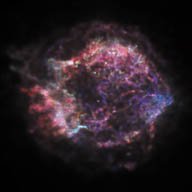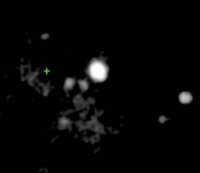ReturnClick to see specific paragraph...Invisible Universe
|
 |
|
Chandra X-Ray Observatory. (CXC) |
When it comes to recording the hottest, most violent, and most bizarre interactions in the universe, X rays win hands down over visible light. During their normal aging process, stars and galaxies give off lots of visible light. But whenever galaxies collide, stars explode, or chunks of matter plunge into massive black holes, they emit a torrent of X rays, which are 100 to 1,000 times more energetic than the light you can see.
Getting high-quality images and spectra of X ray-emitting objects isn't easy. Unable to penetrate Earth's atmosphere, this high-energy radiation can only be detected by spacecraft. Even then, X rays are notoriously difficult to focus into an image since they tend to be absorbed, rather than reflected, by telescopes' mirrors.
Until the summer of 1999, the best X-ray images that astronomers could produce were revealing but blurry. The pictures were only three times as sharp as the visible-light observations that Galileo made nearly 400 years ago by looking through a new device called a telescope.
In July 1999, however, NASA launched the Chandra X-ray Observatory, a $1.5 billion satellite that can resolve X-ray details 10 times more sharply than any previous mission could. Indeed, the clarity provided by the new observatory rivals what all but the very best ground-based telescopes can produce with visible light. Last December, the European Space Agency launched the X-ray Multi-Mirror Mission (XMM)-Newton observatory, which has a lower resolution but can see dimmer objects than Chandra can.
Already, Chandra has scrutinized supernova explosions as never before and found evidence of a new type of black hole. It has also resolved the myriad point sources that make up the cosmos' X-ray background. Spectra taken by XMM-Newton have provided the best data yet on the supermassive black holes that lurk at the cores of galaxies.
Together, these two instruments are creating a new era in X-ray astronomy, researchers say. Astronomers find they can now see sharply and deeply enough in the X-ray spectrum to solve some long-standing mysteries and uncover some new ones.
Right from the get go, Chandra has been providing answers to questions that have long puzzled astronomers. For its first official quarry, the observatory examined a 320-year-old supernova remnant—an expanding shell of gas hurled from an exploded star. Astronomers had expected that the star would have left behind a superdense, burned-out cinder at the core of the remnant, dubbed Cassiopeia A. Previous X-ray missions, as well as observations with radio and visible-light telescopes on the ground, revealed no such object, however.
 |
|
The supernova remnant Cassiopeia A. In this image, the intensity of low-, medium-, and high-energy X rays are shown in red, green, and blue, respectively. The red area on the left outer edge is enriched in iron, whereas the greenish-white region on the lower left is enriched in sulfur and silicon. (NASA/CXC/SAO/Rutgers/Hughes) |
One hour after staring at Cassiopeia A, some 11,000 light-years from Earth, Chandra found a central dot of X-ray light. It appeared to originate from a collapsed star of the type called a neutron star. Such an object has a density 50 trillion times greater than that of lead.
"Everyone knew there should be a neutron star there, but no one had seen it," notes Andrea H. Prestwich of the Harvard-Smithsonian Center for Astrophysics in Cambridge, Mass. "With Chandra's resolution, suddenly it was there."
"We were astounded by the images," says Harvey N. Tananbaum, Chandra science director at Harvard-Smithsonian. "We see the collision of the debris from the exploded star with the matter around it; we see [for the first time] shock waves rushing into interstellar space at millions of miles per hour; and, as a real bonus, we see for the first time a tantalizing bright point near the center of the remnant that could possibly be a collapsed star associated with the outburst."
Using calculations based on the intensity and distribution of the X-ray emission, Deepto Chakrabarty of the Massachusetts Institute of Technology and his colleagues suggest the object might be a magnetar, a neutron star with an enormous magnetic field of 100 trillion to 1,000 trillion gauss. Astronomers so far have found evidence for only a handful of magnetars.
If many supernova remnants turn out to be magnetars, the finding would require "a dramatic revision of our generally accepted notion of the nature of compact objects found in supernova remnants," Chakrabarty and his colleagues say in an article scheduled to appear early next year in the Astrophysical Journal.
In the Jan. 10 Astrophysical Journal Letters, another team of astronomers considered the same observations of Cassiopeia A from another viewpoint. They reported "the first unequivocal identification" of newly forged iron in a young supernova remnant. Scientists think that the heavy metal arises from a chain of nuclear reactions that begins deep within the core of an exploded star.
That's a nice confirmation of the standard theory of supernovas. But there's a surprise, too. The knots of iron found by the team lie at the outer edge of the expanding remnant, much farther from the core of Cassiopeia A than the silicon atoms do. Even though the iron was forged in the star's deepest layers, where temperatures reach 5 billion kelvins, it somehow sped ahead of the silicon, which was generated farther from the core in a region 2 billion kelvins cooler. It's as if the exploded star had turned itself inside out.
"These results require that a spatial inversion of a significant portion of the star's core has occurred," says John P. Hughes of Rutgers University in Piscataway, N.J., and his coauthors. Hughes says the findings argue against the prevailing notion that a supernova explodes in an orderly, symmetric fashion, with its outermost layers staying ahead of the innermost ones.
"It's fair to say that when you put on the sharper glasses of Chandra, you find out that many of the assumptions that you had made before [about supernovas] were just wrong," notes Richard F. Mushotzky of NASA's Goddard Space Flight Center in Greenbelt, Md.
 |
|
Green cross marks the site of a new type of black hole found in the galaxy M82. (NASA/SAO/CXC) |
Soon after studying Cassiopeia A, Chandra cast its X ray eye on another supernova remnant, the famed Crab nebula. The explosion that gave birth to the Crab was so bright that Chinese observers in A.D. 1054 viewed the spectacle in daylight.
The Chandra images show a brilliant ring encircling the spinning neutron star at the heart of the nebula, which lies about 6,000 light-years from Earth. The ring, notes J. Jeffrey Hester of Arizona State University in Tempe, may help explain how a spinning neutron star transports its energy into surrounding space. "It's like finding the transmission lines between the power plant and the light bulb," he says.
In another burst of new findings, researchers announced last month that Chandra appears to have collected evidence for a new type of black hole. Observing the galaxy M82 over a period of 8 months, Chandra found a bright, concentrated source of X rays about 600 light-years from the galaxy's center. The intensity of the source increased dramatically between last January and March.
The concentration of light and its brightness, which is equivalent to the luminosity of 18 million suns, indicates that the X rays are being produced as material heats up and falls onto a black hole. No ordinary black hole, this one has an estimated mass of between 500 and 8,000 suns, says Philip E. Kaaret of Harvard-Smithsonian. That's a range that astronomers have never encountered before.
Supermassive black holes at the centers of galaxies weigh several million to several billion times the mass of the sun; individual stars that collapse under their own weight to become black holes are as massive as a dozen suns. The new find "is the best case yet for a midsize black hole," says Douglas O. Richstone of the University of Michigan in Ann Arbor. "This object is the missing link."
No one is certain how either midsize or supermassive black holes form, he adds, but the existence of the midsize objects may ultimately "lead the way to a formation mechanism for the big ones."
Kaaret notes that M82 is a starburst galaxy: It contains an abundance of massive stars. Such stars are born, age, and die all within the astronomically brief time of a few tens of millions of years. His team suspects that the dense starburst activity may have created the midsize black hole, possibly through the collision of several newborn stars or stellar black holes.
The researchers suggest that midsize black holes may be common in the star-forming regions of many galaxies. If so, these black holes, like the starbursts, are young. As the midsize black holes grow older, they may either stop feeding on hot gas and fade or sink into the nucleus of their home galaxy, becoming part of a supermassive black hole.
On an even grander scale, supermassive black holes figure in another puzzle solved by Chandra. For nearly 40 years, astronomers have tried to identify the origin of the faint glow of X rays that bathe the sky. Chandra's sharp vision has resolved this glow into millions of individual sources. Many of them, Chandra reveals, are active galactic nuclei—galaxies whose cores contain massive black holes.
"You look at a given patch of sky with Chandra and our best optical telescope. We can see 10 times more [active galactic nuclei] with Chandra," notes Mushotzky. "Chandra sees essentially all the massive black holes that there ever were, which I think is a pretty nifty discovery."
Curiously, a few of the sources of X rays show no trace of visible light (SN: 1/15/00, p. 36). One explanation is that these objects are extremely distant. Because of cosmic expansion, distant galaxies recede faster from Earth than nearby galaxies do and, as a result, the light they emit is shifted to longer, or redder, wavelengths. The puzzling objects might lie so far away-at the very edge of the observable universe—that the visible light they radiate is completely shifted into the infrared.
 |
|
European Space Agency's X-Ray Multi Mirror-Newton satellite, showing the openings for its three telescopes. (ESA) |
Because looking far back in space is the same as looking far back in time, galaxies that distant would be among the first to form.
Why should the very first galaxies shine so brightly with X rays? If black holes formed the seeds around which galaxies coalesced, they would readily emit X rays as matter falls into them, Tananbaum notes.
Says Mushotzky, "The big thing we've learned in the last 2 years from the Hubble and the Keck telescopes [in Hawaii], and now Chandra, is that massive black holes and the galaxies [they reside in] are intimately related to each other." Exactly how remains a mystery. "Does the galaxy come first, or does the massive black hole become the seed around which the galaxy will originate?" Mushotzky wonders.
"Chandra homes in on the nucleus [of a galaxy], while Hubble and other telescopes are exquisitely sensitive to star formation, and by combining observations, hopefully we'll figure this out," he says. "The best argument is that...the black hole at the center of a galaxy and the galaxy-formation process are one and the same."
Several years ago, researchers using a Japanese X-ray satellite called ASCA explored other properties of supermassive black holes. They found a new way to probe the extreme-gravity environment around these black holes. Ionized iron atoms emit X rays of particular wavelengths that show up as a sharp peak in the recorded spectrum. But in the vicinity of a black hole, these peaks broaden, or stretch. The amount of stretching, the scientists found, appears to be proportional to the mass of the black hole and its spin.
Using the XMM-Newton satellite, researchers recently studied X-ray emissions from the core of two galaxies suspected of harboring supermassive black holes. Steven M. Kahn and Masao Sako of Columbia University and their colleagues have now found stretching in three additional emission features: narrow bands of X-ray light produced by carbon, oxygen, and nitrogen ions. The researchers attribute the distortion to a black hole's tug.
According to models, the regions responsible for the emissions lie just above and below the swirling disks of material surrounding black holes. The radiation is likely to provide vital information about the nature of the superdense objects, Kahn says. As with the iron emission, the amount of stretching may indicate the size and spin of the black hole.
Because the newly found emission features are brighter than those of the iron emission, they should be easier to detect, he notes. Kahn's colleague, Graziella Branduardi-Raymont of University College London, reported the findings last month at a meeting on X-ray astronomy in Palermo, Italy.
Chandra achieves its superior vision through four nested mirrors, each shaped like a cylinder, which cost a total of $250 million. XMM-Newton uses a trio of telescopes that focus on the same object. X-ray telescopes require such complicated optics to avoid absorbing the radiation. This design allows X rays to graze a mirror, like stones skipping across water. At an angle of less than 1¡, they can reflect and converge to produce a focused image.
Although, Chandra and XMM have already made great advances, X-ray astronomy is just starting to hit its stride. Astronomers predict that by combining the light of a network of observatories, they will ultimately be able to see details 1 million times better than they can with Chandra.
At NASA's Marshall Space Flight Center in Huntsville, Ala., a laboratory model of such an array has achieved about the same resolution in X rays as the Hubble Space Telescope can attain in visible light, researchers reported last month.
That work has given a kick start to two proposed X-ray missions that would rely on a fleet of X-ray detectors. If these missions come to pass, X-ray telescopes a decade or so from now will see distant stars not as points of light but as bona fide disks, showing details as rich as we can now discern on the sun. A fleet of such devices would be the first to peer down the throat of a black hole, taking an image of hot, X ray-emitting gas swirling around the hole just before it disappears down the hatch.
Science News, Vol 158, 10/21/00